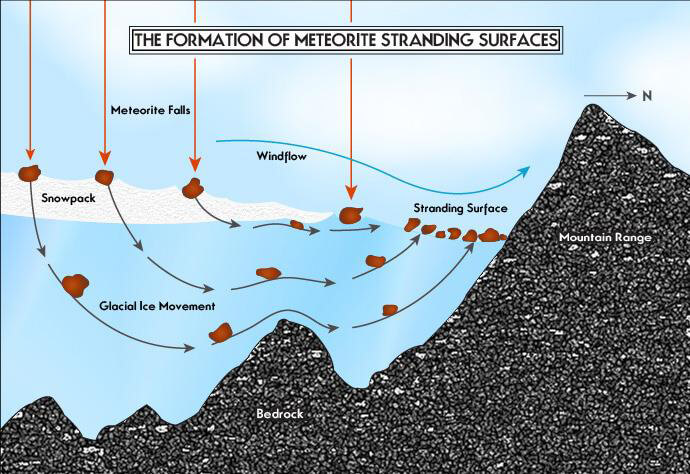
February 23, 2016
A ground breaking study published in Nature Communications this week by a group of researchers from the University of Manchester grabbed news headlines as it proposed that the lack of iron containing meteorites collected in Antarctica is due to their high thermal conductivity. Antarctica has long been a treasure trove for scientists studying meteorites, in fact, 66.3% of all meteorites collected on the planet were discovered there. This is due to the presence of glacial ice sheets known as meteorite stranding zones, which bring meteorites that have long been buried in the ice to the surface through a combination of upward ice flow and ablation (Figure 1). However, the number of meteorites composed of or containing iron discovered in Antarctica is much lower than in other areas of the globe.

Figure 1. Diagram illustrating how meteorites are pushed to the surface of Antarctic ice, making it an ideal area for meteorite study and collection. 1
Evatt et al. (2016) hypothesized that meteorites containing iron do not make it to the surface where they can be collected and studied, as their high thermal conductivity results in them gaining enough heat from the sun as they approach the surface that they melt their way down through the ice faster than it can push them up. They set out to prove their predictions through a combination of laboratory testing and mathematical modeling. Two different meteorites, one composed of iron, the other iron free, were encased in blocks of ice. A strong light mimicking the sun was shone on each meteorite, and the rate with which each sank as they heated and melted the ice around them was measured.
The meteorite containing iron melted its way through the ice at a much higher rate than the one that did not. Evatt et al. (2016) also developed a mathematical model, in which the thermal conductivity of the iron meteorite was estimated at 25 W/mK. The model produced results that closely agreed with the laboratory testing. The application of this model to Antarctic conditions revealed that meteorites with high thermal conductivities (in this case higher than 4 W/mK), would remain trapped in the ice, while those with lower conductivities would be pushed to the surface.
This study is an exciting step in understanding why the proportion of iron meteorites collected in Antarctica is so different from other areas of the world. What is most fascinating about this research is that the authors conclude that sublayers of ice containing these missing iron containing meteorites may exist just below the surface. If recovered, these ancient meteorites have the potential to help scientists discover new information about the beginning of our solar system, and the type of asteroids that existed during that time.
To read that article by Evatt et al. (2016) in Nature Communications, please follow this link: http://www.nature.com/ncomms/2016/160216/ncomms10679/full/ncomms10679.html
Sources
Evatt, G.W., Coughlan, M.J., Joy, K.H., Smedley, A.R.D., Connolly, P.J., and Abrahams, I.D. 2016. A potential hidden layer of meteorties below the ice surface of Antarctica. Nature Communications. 7.
Photo References:
1- http://expeditions.fieldmuseum.org/antarctic-meteorites/blog/6-meteorite-spotting-practice-sessions